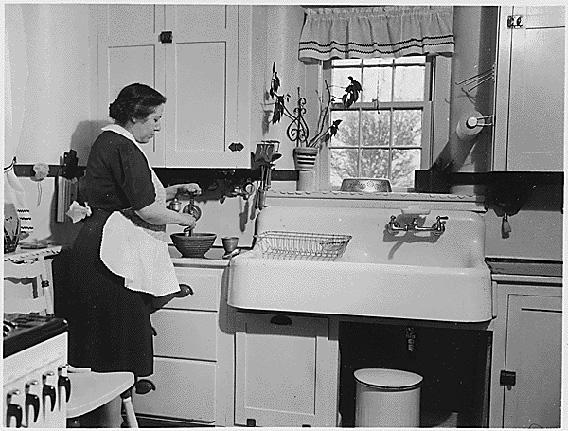 Frank and Lillian Gilbreth with 11 of their 12 children
Frank and Lillian Gilbreth with 11 of their 12 children Purdue Libraries' Archives and Special Collections.
The idea that housework is work now seems like a commonplace. We contract it out to housekeepers, laundromats, cleaning services, takeout places. We divvy it up: You cooked dinner, I?ll do the dishes. We count it as a second shift, as well as primary employment. But it wasn?t until the early part of the 20th century that first a literature, and then a science, developed about the best way to cook and clean. The results of this research shape the way we treat housework today, and created a template for the kitchen that remains conceptually unchanged from the 1920s. And the woman who made the kitchen better? She couldn?t cook.
If that sounds like the set-up for a comedy, that?s because it was. Lillian Moller Gilbreth, industrial psychologist and engineer, was the mother of 12 children. She and husband and partner Frank B. Gilbreth, inventors of what is known as motion study, pioneered the use of short films to watch how industrial processes and office tasks were done, breaking them down into component parts (which they called ?therbligs,? Gilbreth backward) to determine how to make a job faster and less taxing. They tested many of their ideas on their children, establishing ?the one best way? to take a bath, training preteens to touch type, and charting age-appropriate chores for each child. The ensuing hijinks provided enough material for memoirs written by two Gilbreth children, Cheaper by the Dozen and Belles on Their Toes.
 Lillian Gilbreth
Lillian Gilbreth Harris & Ewing/ Smithsonian Institution Archives/Wikimedia Commons.
While Frank Gilbreth was alive, he and Lillian worked for industry. She wrote or co-wrote many of his books, but often took no credit, as it was Frank with whom the male executives wanted to deal. After his sudden death in 1924, she had to re-establish herself as a solo female practitioner. According to biographer Jane Lancaster, in Making Time, Gilbreth soon saw that combining her professional expertise on motion study with her assumed expertise on women?s work gave her a marketable niche.
Frank B. Gilbreth Jr. and Ernestine Gilbreth Carey write, in Belles on Their Toes:
If the only way to enter a man?s field was through the kitchen door, that?s the way she?d enter? Mother planned, on paper, an efficiency-type kitchenette of the kind used today in a good many apartments. Under her arrangement, a person could mix a cake, put it in the oven, and do the dishes, without taking more than a couple of dozen steps.
It had to be cake, because that was one of few dishes Gilbreth made well. Gilbreth had grown up in an upper class household in California with a Chinese chef. She had worked side-by-side with Frank Gilbreth from the day they married. As she told a group of businesswomen in 1930, ?We considered our time too valuable to be devoted to actual labor in the home. We were executives.?And family councils, at the Gilbreth home in Montclair, were run like board meetings.
Even though she did not do it herself, Gilbreth still considered housework unpaid labor, and as such, capable of efficiencies. The worker in the kitchen in the 1920s was often not a servant but the lady of the house, who spent an estimated 50 percent of her day there. The refrigerator had begun to arrive in middle-class homes, but was the subject of a pitched battle between gas and electric companies as to who made the superior chiller. Smaller electric appliances were also in development. ?Home economists? raised the bar for domestic health and hygiene. Women became the targets of intense marketing campaigns for products large and small. Gilbreth worked for these manufacturers, and thus is complicit in the rise of consumerism for the home, but she never made explicit endorsements.
She did, however, partner with the Brooklyn Borough Gas Company to develop Gilbreth?s Kitchen Practical, unveiled in 1929 at a Women?s Exposition. The kitchen was intended to showcase the new gas-fueled appliances as well as Gilbreth?s research on motion savings. It was to replace the loose-fit kitchen of many traditional homes (including the Gilbreths?): a large room with discrete pieces of furniture around the edges. These might include a table, a freestanding cupboard or Hoosier cabinet, an icebox, a sink with a drying board and a stove. Ingredients, utensils and cookware might be across the room, or even in a separate pantry.
 Kitchen layout typical of the pre-Kitchen Practical Design era, around 1920-1954
Kitchen layout typical of the pre-Kitchen Practical Design era, around 1920-1954 Department of Agriculture/National Archives.
To the contemporary eye, the Gilbreth Kitchen Practical looks hopelessly old-fashioned, but that has more to do with the 1920s appliances styled like pieces of leggy furniture than it does with Gilbreth?s layout. Working outward from her analysis of the motions, equipment and ingredients required to bake a cake, Gilbreth put stove and counter side-by-side, with food storage above, pan storage below, and the refrigerator a step away. A rolling cart provided additional surface area, and could be wheeled to the sink with a load of dirty dishes, where soap, sponge and drying rack were all within reach. The idea was to create a tight circuit for the cook, with no need to move the feet. The L-shaped arrangement she devised continues to be one of the most popular options for contemporary kitchens. (Yours is likely to be an L, C, or U.)
Source: http://feeds.slate.com/click.phdo?i=22aa92170c13d4628281999a0dc0b7cf
space shuttle cam newton Torrey Smith Brother fiona apple awkward awkward chase
No comments:
Post a Comment
Note: Only a member of this blog may post a comment.